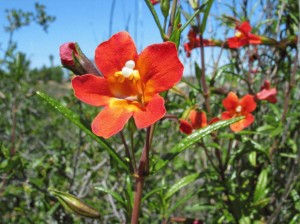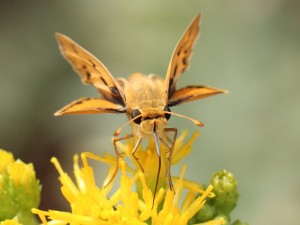
The Native California Monkey Flower is reasonably fire safe and has a long bloom cycle in the Rose Creek Watershed. Monkey flowers can be seen in bloom for months in the spring the canyons of Clairemont and University City.
Photo: Walter Shaw
A wide diversity of native habitats can be found throughout the Rose Creek Watershed undeveloped areas. These habitats provide safe homes for many types of animals that you can often spot when hiking or biking through the watershed’s many trails.
The following habitats can be found on the north-facing slopes:
- Southern mixed chaparral
- Non-native grassland
- Scrub willow
- Willow riparian forest
- Coast live oak riparian
- Freshwater marsh

A woodland skipper on golden bush, a native California plant found in the Rose Creek Watershed. Photo by Roy Little.
Other habitats are found on the south-facing slopes:
- Coastal sage scrub
- Non-native grassland
- Native grassland
A very rare native habitat known as vernal pools can be found in the area of Nobel Drive and I-805.
Our thanks to the City of San Diego; Ed Ervin of Merkel and Associates, Dr. Susan Hector; Mike Kelly of the Conservation Resources Network; Carrie Schneider of the California Native Plant Society; Ben Stevenson of the Rose Canyon Recreation Council; Mark Woodworth with the Tri-canyon Weed Warriors; Tri-canyon park volunteer Joe Matista; landscape architect Kay Stewart; Dave Boyer of the Miramar Marine Corps Air Station, Natural Resources Division; The Nature Conservancy and the Friends of Rose Canyon for their help with the information in this section.
